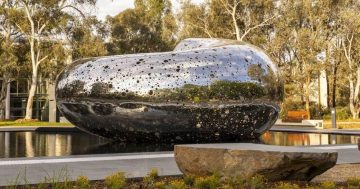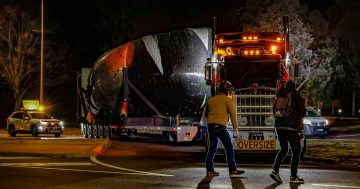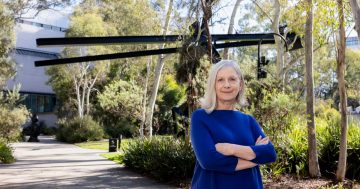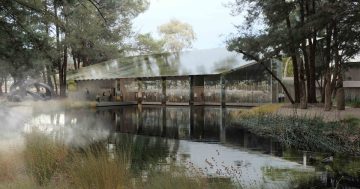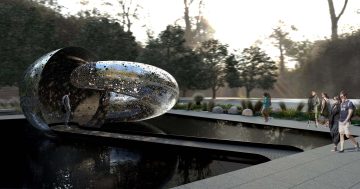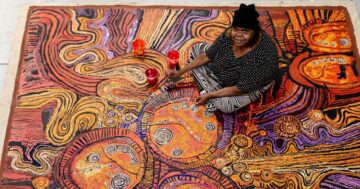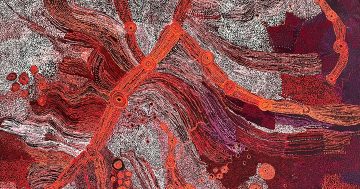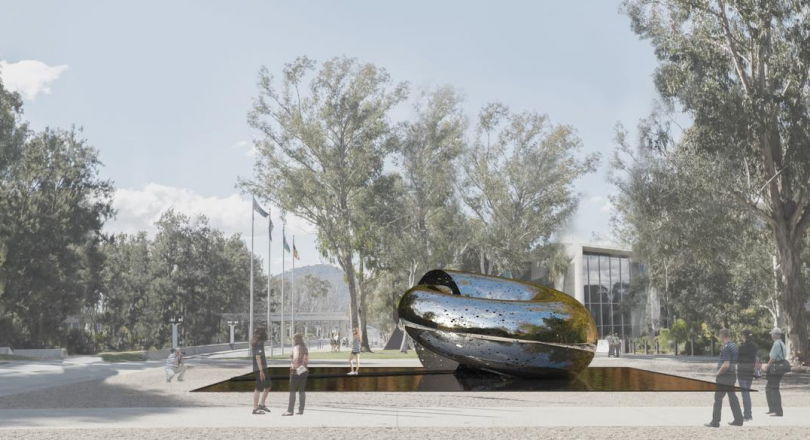
Lindy Lee’s proposed sculpture for the National Gallery. Image: Supplied.
A four-metre sculpture weighing 13 tonnes and with a $14 million price tag will be acquired by the National Gallery of Australia (NGA) to mark its 40th anniversary.
Artist Lindy Lee has been commissioned to create Ouroboros, a polished stainless steel work based on the ancient image of a snake eating its tail. It’s the most expensive work the gallery has acquired and the cost will be met by the NGA’s Collection Development Fund.
Ouroboros will incorporate recycled materials and is intended to be one of Australia’s first sustainably-produced works of public art.
The interactive work will become part of a new public gateway for visitors to the gallery. People will be able to enter the mouth and walk into the curved space, illuminated by light beams from hundreds of thousands of perforations on its surface.
Lee says an ouroboros symbolises repetition and renewal of the abundance of cyclical time, eternal flow, unity of the beginning and in the end, transformation and alchemy.
Its mirror-like surface will reflect the gallery environment during the day in much the same way that Bert Flugelman’s highly polished Cones attract passers-by, while at night the work will be internally lit.
“It is a dance between something that is solid and something that is just drifting off into stardust,” the artist said.
Lee, who is better known for her painting, has enjoyed a lengthy international art career over four decades.
She is influenced by eastern philosophies including Taoism and Buddhism and as a Chinese-Australian artist, has examined the Chinese diaspora experience in Australia.
Her most recent work pushes concept and scale, developing massive pieces in collaboration with other artisans while remaining closely involved with the creative process. She has also been commissioned to produce major public art pieces in China.
NGA Director Nick Mitzevich said the work would represent a defining moment in the gallery’s history as it looks to the future.
“It will be a landmark for the national gallery and Canberra and is representative of our vision to be an equitable, inclusive and sustainable institution as we embark on the next 40 years,” he said.
“Lindy was asked to be bold and ambitious in her vision for this project and she has exceeded our expectations. We are excited to be able to present a work that reframes and reinvigorates the Sculpture Garden but also sparks conversation and is emblematic of the times.”
The 1981 gardens, planted entirely with Australian natives, includes 26 artworks ranging from Fujiko Namaya’s fog sculpture to a life-sized maquette for Antony Gormley’s Angel of the North which faces the lake.
Significant design changes in recent years including the Gandel Hall construction and new front entrance have changed the gardens’ flow, obscuring some earlier works including Fiona Hall’s Fern Garden.
Lee’s proposed work will feature at the National Gallery’s main entrance at the corner of King Edward Terrace and Parkes Place East, and will be accessible day and night.
It will be the first commission for the Sculpture Garden since the opening of James Turrell’s Skyspace Within without in 2010 and forms part of the national gallery’s plan to renew the gardens which were established 40 years ago.
The NGA will now seek approval for the installation works from the National Capital Authority and work is due to be completed in early 2024.












